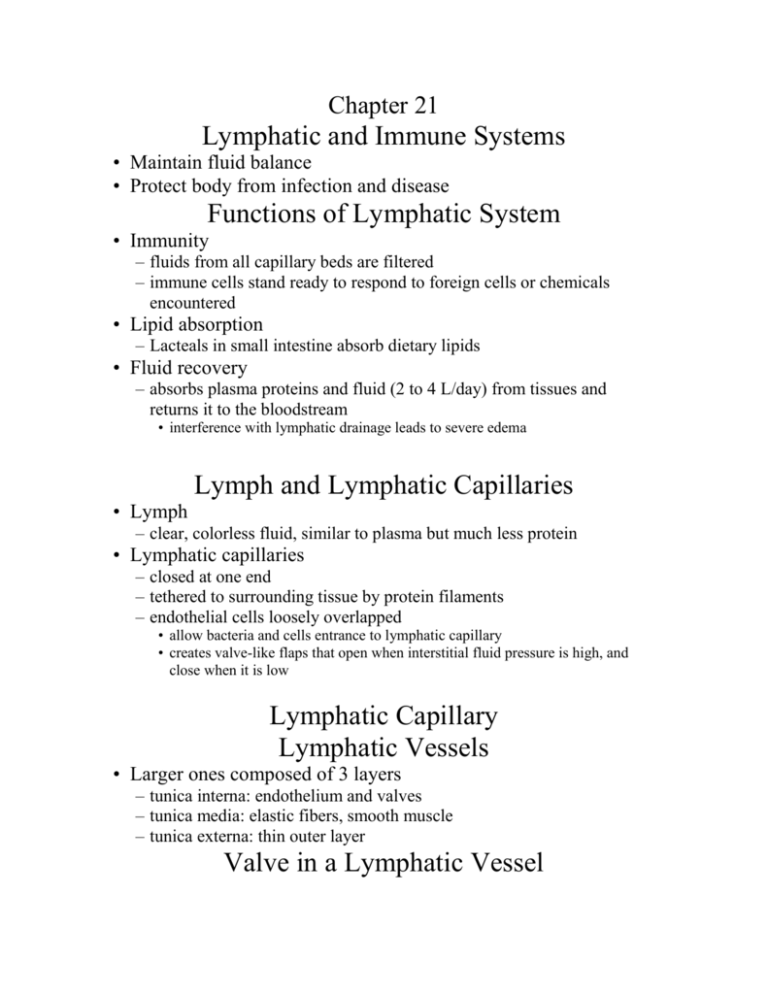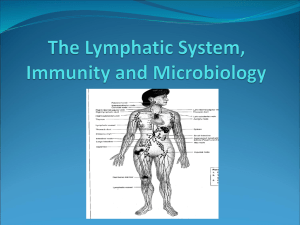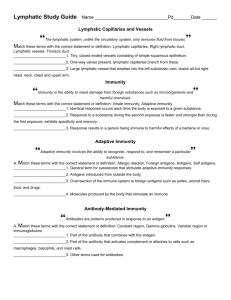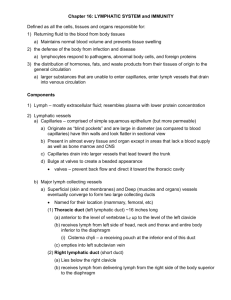Chapter Outline
advertisement

Chapter 21 Lymphatic and Immune Systems • Maintain fluid balance • Protect body from infection and disease Functions of Lymphatic System • Immunity – fluids from all capillary beds are filtered – immune cells stand ready to respond to foreign cells or chemicals encountered • Lipid absorption – Lacteals in small intestine absorb dietary lipids • Fluid recovery – absorbs plasma proteins and fluid (2 to 4 L/day) from tissues and returns it to the bloodstream • interference with lymphatic drainage leads to severe edema Lymph and Lymphatic Capillaries • Lymph – clear, colorless fluid, similar to plasma but much less protein • Lymphatic capillaries – closed at one end – tethered to surrounding tissue by protein filaments – endothelial cells loosely overlapped • allow bacteria and cells entrance to lymphatic capillary • creates valve-like flaps that open when interstitial fluid pressure is high, and close when it is low Lymphatic Capillary Lymphatic Vessels • Larger ones composed of 3 layers – tunica interna: endothelium and valves – tunica media: elastic fibers, smooth muscle – tunica externa: thin outer layer Valve in a Lymphatic Vessel Route of Lymph Flow • • • • Lymphatic capillaries Collecting vessels: course through many lymph nodes Lymphatic trunks: drain major portions of body Collecting ducts : – right lymphatic duct – receives lymph from R arm, R side of head and thorax; empties into R subclavian vein – thoracic duct - larger and longer, begins as a prominent sac in abdomen called the cisterna chyli, receives lymph from below diaphragm, left arm, left side of head, neck and thorax; empties into L subclavian vein The Fluid Cycle Lymphatic Drainage of Mammary and Axillary Regions Drainage of Thorax Mechanisms of Lymph Flow • Lymph flows at low pressure and speed • Moved along by rhythmic contractions of lymphatic vesselsstretching of vessels stimulates contraction • • • • Flow aided by skeletal muscle pump Thoracic pump aids flow from abdominal to thoracic cavity Valves prevent backward flow Rapidly flowing bloodstream in subclavian veins, draws lymph into it • Exercise significantly increases lymphatic return Lymphatic Cells • T lymphocytes – Mature in thymus • B lymphocytes – Activation causes proliferation and differentiation into plasma cells that produce antibodies • Antigen Presenting Cells – Macrophages (from monocytes) – dendritic cells (in epidermis, mucous membranes and lymphatic organs) – reticular cells (also contribute to stroma of lymph organs) Lymphatic Tissue • Diffuse lymphatic tissue: lymphocytes in mucous membranes and CT of many organs – Mucosa-Associated Lymphatic Tissue: particularly prevalent in passages open to the exterior • Lymphatic nodules: dense oval masses of lymphocytes, congregate in response to pathogens – Peyer patches: more permanent congregation, clusters found at junction of small to large intestine Lymphatic Organs • At well defined anatomical sites, have CT capsules • Lymph nodes – cervical, axillary and inguinal regions close to surface – thoracic, abdominal and pelvic groups deep in cavities • Tonsils – guard entrance to pharynx • Thymus – between sternum and aortic arch • Spleen – inferior to diaphragm, dorsolateral to stomach Lymph Node • Lymph nodes - only organs that filter lymph • Fewer efferent vessels, slows flow through node • Capsule gives off trabeculae, divides node into compartments containing stroma (reticular CT) and parenchyma (lymphocytes and APCs) subdivided into cortex (lymphatic nodules) and medulla – reticular cells, macrophages phagocytize foreign matter – lymphocytes respond to antigens – lymphatic nodules-germinal centers for B cell activation Lymphadenopathy • Collective term for all lymph node diseases • Lymphadenitis – swollen, painful node responding to foreign antigen • Lymph nodes are common sites for metastatic cancer – swollen, firm and usually painless Lymph Node Tonsil • Covered by epithelium • Pathogens get into tonsillar crypts and encounter lymphocytes Location of Tonsils • Palatine tonsils – pair at the posterior margin of oral cavity; most often infected • Lingual tonsils – pair at the root of tongue • Pharyngeal tonsil (adenoid) – single tonsil on wall of pharynx Thymus Thymus • Capsule gives off trabeculae, divides parenchyma into lobules of cortex and medulla • Reticular epithelial cells – form blood thymus barrier in cortex • isolates developing T lymphocytes from foreign antigens – secretes hormones (thymopoietin, thymulin and thymosins) • to promote development and action of T lymphocytes • Very large in fetus, after age 14 begins involution – in elderly mostly fatty and fibrous tissue Histology of Thymus Spleen • Parenchyma appears in fresh specimens as – red pulp: sinuses filled with erythrocytes – white pulp: lymphocytes, macrophages; surrounds small branches of splenic artery • Functions – blood production in fetus – blood reservoir – RBC disposal – immune reactions: filters blood, quick to detect antigens Spleen Defenses Against Pathogens • Nonspecific defenses - broadly effective, no prior exposure – external barriers – phagocytic cells, antimicrobial proteins, inflammation and fever • Specific defense - results from prior exposure, protects against only a particular pathogen – immune system External Barriers • Skin – – – – toughness of keratin dry and nutrient-poor defensins: peptides, from neutrophils attack microbes lactic acid (acid mantle) is a component of perspiration • Mucous membranes – stickiness of mucus – lysozyme: enzyme destroys bacterial cell walls • Subepithelial areolar tissue – tissue gel: viscous barrier of hyaluronic acid • hyaluronidase: enzyme used by pathogens to spread Leukocytes and Cutaneous Defenses • Neutrophils – phagocytize bacteria – create a killing zone • degranulation: lysosomes discharge into tissue fluid, triggers • respiratory burst: toxic chemicals are created (O2.-, H2O2, HClO) • Eosinophils – phagocytize antigen-antibody complexes, allergens, inflammatory chemicals – antiparasitic effects: aggregate and release enzymes Other Leukocytes • Basophils – aid mobility and action of WBC’s by the release of • histamine (vasodilator) blood flow to infected tissue • heparin (anticoagulant) prevents immobilization of phagocytes • Monocytes – circulating precursors to macrophages • Lymphocytes – natural killer (NK) cells, nonspecific defense, large cells lyse host cells infected with viruses or cancerous by release of perforin proteins Action of Perforin Antimicrobial Proteins • Interferons: polypeptides secreted by cells invaded by viruses – antiviral effect • generalized protection • interferons diffuse to neighboring cells and stimulate them to produce antiviral proteins • activate natural killer cells and macrophages – destroy infected host cells – anticancer effect • stimulate destruction of cancer cells Complement System • Group of proteins in blood that must be activated by pathogens to exert their effect • Pathways of complement activation (see next slide) – classical pathway – alternate pathway • Mechanisms of action (see next slide) – enhanced inflammation – opsonization (promotes phagocytosis) – cytolysis (membrane attack complex) Complement Activation Membrane Attack Complex • Complement proteins C5b to C9 form ring in plasma membrane of enemy cell causing cytolysis Inflammation • Defensive response to tissue injury – limits spread of pathogens, then destroys them; removes debris, initiates tissue repair – suffix -itis denotes inflammation of specific organs • Cardinal signs – – – – redness (erythema) caused by hyperemia ( blood flow) swelling (edema) caused by capillary permeability and filtration heat caused by hyperemia pain caused by inflammatory chemicals (bradykinin, prostaglandins) secreted by damaged cells, pressure on nerves Mobilization of Defenses • Bradykinin, histamine and leukotrienes are secreted by damaged cells, basophils (blood) and mast cells (tissue) – stimulates vasodilation that leads to hyperemia • causes redness and heat: local metabolic rate, promotes cell multiplication and healing • dilutes toxins, provides O2, nutrients, waste removal – stimulates permeability of blood capillaries • allows blood cells, plasma chemicals (antibodies, complement proteins, fibrinogen) into tissue • clotting sequesters bacteria, forms scaffold for tissue repair Mobilization of Defenses • Leukocyte Deployment – margination • leukocytes adhere to blood vessel walls (cell adhesion molecules) – diapedesis • leukocytes squeeze between endothelial cells into tissue space Containment and Destruction of Pathogens • Fibrinogen now in tissue clots, trapping microbes • Heparin prevents clotting at site of injury – pathogens trapped in a fluid pocket surrounded by clot • Chemotaxis – leukocytes are attracted to inflammatory chemicals • Neutrophils are quickest to respond – phagocytosis – respiratory burst – secrete cytokines for recruitment of macrophages and T cells Tissue Cleanup • Monocytes the primary agents of cleanup arrive in 8 to 12 hours, become macrophages, • Edema venous flow, lymphatic flow that favors removal of bacteria and debris • Formation of pus – mixture of tissue fluid, cellular debris, dying neutrophils and microbes Tissue Repair • Blood platelets and endothelial cells in injured area secrete a cytokine, PDGF, that stimulates fibroblasts to multiply and synthesize collagen • Facilitated by hyperemia that provides materials needed and heat that increases metabolism • Fibrin clot may provide a scaffold for repair • Pain limits use of body part allowing for repair Fever • Defense mechanism: can do more good than harm – promotes interferon activity – accelerating metabolic rate and tissue repair – inhibiting pathogen reproduction • A cytokine, interleukin 1 is called a pyrogen – secreted by macrophages, stimulates anterior hypothalamus to secrete PGE which resets body thermostat higher > 105F may cause delirium, 111F- 115F, coma-death • Stages of fever – onset, stadium, defervescence Course of a Fever Specific Immunity • Specificity and memory • Cellular immunity: cell-mediated (T cells) • Humoral immunity: antibody mediated (B cells) Passive and Active Immunity • Natural active immunity (produces memory cells) – production of one’s own antibodies or T cells as a result of infection or natural exposure to antigen • Artificial active immunity (produces memory cells) – production of one’s own antibodies or T cells as a result of vaccination • Natural passive immunity (through placenta, milk) – temporary, fetus acquires antibodies from mother • Artificial passive immunity (snakebite, rabies, tetanus) – temporary, injection of immune serum (antibodies) Antigens • Trigger an immune response • Complex molecules – > 10,000 amu, unique structures – proteins, polysaccharides, glycoproteins, glycolipids • Antigenic determinants (see next slide) – stimulate immune responses • Haptens – too small, host macromolecule must bind to them to stimulate immune response Antigenic Determinants Lymphocytes • Specific immunity depends on lymphocytes • Types of lymphocytes in circulating blood – 80% T cells (cell mediated) – 15% B cells (antibody mediated) – 5% NK cells (nonspecific immunity) T Lymphocytes (T cells) • Stem cells of fetus colonize thymus for 2-3 days • Thymosins stimulate maturing T cells to produce antigen receptors – immunocompetent cell: antigen receptors in place Negative Selection of T cells in Thymus • Immunocompetent T cells must be able to – bind to RE cell – not react to self antigens • Failing either of these results in negative selection via – clonal deletion: destruction of offending T cell clones – anergy: inactive state, alive but unresponsive – leaves the body in a state of self-tolerance Positive Selection of T cells in Thymus • Immunocompetent T cells that are able to – bind to MHC on RE cell – not react to self antigens • divide rapidly and form a clone of T cells with identical receptors for antigen These cells leave thymus to colonize lymphatic tissues and organs B Lymphocytes (B cells) • Sites of development – fetal stem cells in liver, bone marrow, junction of small and large intestine and appendix • B cell selection – should not bind to MHC on self cells (not cell mediated) – should also not react to self antigens • Selected cells form B cell clones – synthesize antigen receptors, divide rapidly, produce immunocompetent clones Antigen-Presenting Cells (APCs) • B cells & macrophages, display antigens to T cells Interleukins • Hormonelike messengers between leukocytes • Lymphokines: produced by lymphocytes • Monokines : produced by macrophages (monocytes are macrophage precursors) Cellular Immunity • • • • • T lymphocytes attack and destroy foreign cells and diseased host cells Involves 4 classes of T cells Cytotoxic (killer) T cells: carry out attack Helper T cells: help promote T cell and B cell action and nonspecific defense mechanisms Suppressor T cells: limit cell mediated attack • Memory T cells: provide immunity from future exposure to antigen TC cell Recognition • Antigen presentation – MHC-I proteins • found on nearly all nucleated body cells • display peptides produced by host cells • TC cell activation – binding of cytotoxic T cells (CD8 cells) to abnormal peptides on MHC-I and – costimulation via a cytokine – triggers clonal selection: clone of identical T cells against cells with same epitope TH cell Recognition • Antigen presentation and T cell activation – role of MHC-II proteins • found only on antigen presenting cells • stimulate helper T cells (CD4 cells) • TH cell activation – binding of helper T cells (CD4 cells) to abnormal peptides ingested and displayed on MHC-II and – costimulation via a cytokine Attack Phase: Role of Helper T Cells • Helper T cells – secretes interleukins – coordinate humoral and cellular immunity Cytotoxic T Cells • Only T cells to directly attack enemy cells • Lethal hit mechanism – – – – contacts cell with antigen-MHC-I protein complex perforin released, destroys target cell lymphotoxins: destroys target cell DNA tumor necrosis factor: kills cancer cells in 2-3 days Cytotoxic T Cell Function • Cytotoxic T cell binding to cancer cell Destruction of Cancer Cell Suppressor T Cells • As pathogen disappears, slows down immune reaction • Prevents autoimmune diseases Memory • Memory T cells – following clonal selection some T cells become memory cells • T cell recall response – upon reexposure to same pathogen, memory cells launch a quick attack Humoral Immunity • Recognition – B cell receptors bind antigen, take in and digest antigen then display epitopes on its MHC-II protein – After costimulation by TH cell, divide repeatedly, differentiate into plasma cells, produce antibodies specific to that antigen • Attack – antibodies bind to antigen, render it harmless, ‘tag it’ for destruction • Memory – some B cells differentiate into memory cells Humoral Immunity - Recognition B cell Plasma cell Antibody Structure Antibody Classes • By amino acid sequences of C region of antibody • IgA: monomer in plasma; dimer in mucus, saliva, tears, milk, intestinal secretions, prevents adherence to epithelia • IgD: monomer; B cell membrane antigen receptor • IgE: monomer; tonsils, skin, mucous membranes; stimulates release of histamines, attracts eosinophils • IgG: monomer; 75-85% circulating, crosses placenta to fetus, secondary immune response, binds complement • IgM: monomer; B cell membrane, antigen receptor; pentamer in plasma, 1 immune response, agglutination Antibody Diversity • Immune system produces as many as 2 million different antibodies • Somatic recombination – DNA segments shuffled and form new combinations of base sequences to produce antibody genes Humoral Immunity - Attack • Neutralization: antibodies mask pathogenic region of antigen • Complement fixation: antigen binds to IgM or IgG, antibody changes shape, initiates complement binding; primary defense against foreign cells, bacteria • Agglutination: antibody has 2-10 binding sites, binds to multiple enemy cells immobilizing them • Precipitation: similar process, antibody binds antigen molecules not cells; creates antigen-antibody complex that precipitates, phagocytized by eosinophil Agglutination and Precipitation Humoral Immunity Responses Hypersensitivity (Allergy) • Excessive immune reaction against antigens that most people tolerate allergens • Type I (acute) hypersensitivity (most common) – anaphylaxis: occurs in sensitized people, allergen caps IgE on mast cells, basophils; release inflammatory chemicals, cause local edema, mucus hypersecretion, congestion; hives, watery eyes, runny nose are typical • Asthma (most common chronic illness in children) – inhaled allergens, histamines, bronchiole constriction • Anaphylactic shock: bronchiolar constriction, dyspnea, vasodilation, shock, death; treatment- epinephrine Type II Hypersensitivity (Antibody-Dependent Cytotoxic) • IgG or IgM binds to antigens on cells and lyses them through complement fixation; transfusion reaction • IgG or IgM binds to cell surface receptors and either interferes with (myasthenia gravis) or overstimulates cell Type III Hypersensitivity (Immune Complex) • Widespread antigen-antibody complexing • Complexes trigger intense inflammation, involved in acute glomerulonephritis and in systemic lupus erythematosus Type IV Hypersensitivity (Delayed) • 12 to 72 hour delay – APC’s in lymph nodes display antigens to helper T cells, which secrete interferon and lymphokines that activate cytotoxic T cells and macrophages • Cosmetic and poison ivy allergies - haptens • TB skin test Autoimmune Diseases • Failure of self tolerance – cross-reactivity – abnormal exposure of self-antigens – changes in structure of self-antigens • Production of autoantibodies Immunodeficiency Diseases • Severe Combined Immunodeficiency Disease – hereditary lack of T and B cells – vulnerability to opportunistic infection Immunodeficiency Diseases • AIDS – HIV structure (next slide) – invades helper T cells, macrophages and dendritic cells by “tricking” them to internalize viruses by receptor mediated endocytosis – reverse transcriptase (retrovirus), uses viral RNA as template to synthesize DNA, new DNA inserted into host cell DNA, may be dormant for months to years HIV Structure AIDS • Signs and symptoms – early symptoms: flulike chills and fever – progresses to night sweats, fatigue, headache, extreme weight loss, lymphadenitis – normal TH count is 600 to 1,200 cells/L of blood but in AIDS it is < 200 cells/L • person susceptible to opportunistic infections (Toxoplasma, Pneumocystitis, herpes simplex virus, CMV or TB – thrush: white patches on mucous membranes may appear – Kaposi sarcoma: cancer originates in endothelial cells of blood vessels causes purple lesions in skin Kaposi Sarcoma HIV Transmission • Through blood, semen, vaginal secretions, breast milk, or across the placenta • Most common means of transmission – sexual intercourse (vaginal, anal, oral) – contaminated blood products – contaminated needles • Not transmitted by casual contact • Undamaged latex condom is an effective barrier to HIV especially with the spermicide nonoxynol-9 Treatment Strategies • Prevent binding to CD4 proteins of TH cells, disruption of reverse transcriptase action or inhibiting assembly of new viruses or their release from host cells • AZT azidothymidine inhibits reverse transcriptase – recommended for CD4 counts below 500 cells/L – side effects include bone marrow toxicity and anemia • Protease inhibitors: inhibit enzymes HIV needs to replicate • HIV is evolving resistance to the “triple cocktail”







